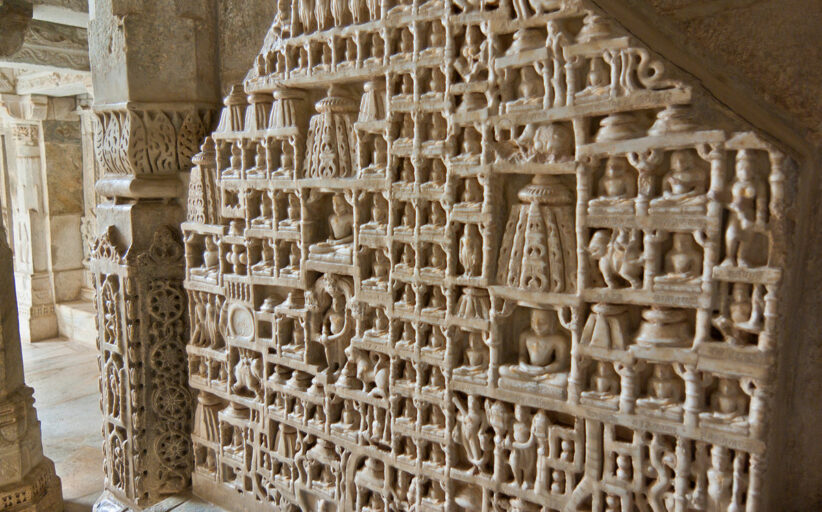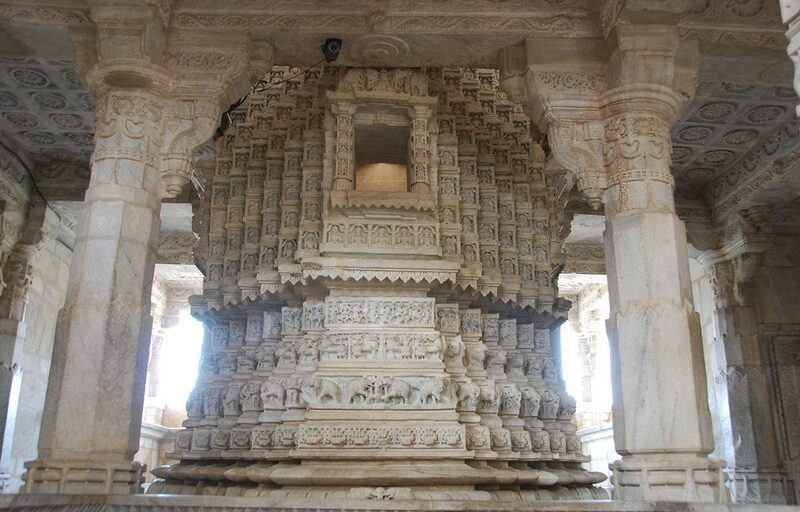There will be no exaggeration if we call the Jain temple of Ranakpur a miracle of craft with religion and faith. Rishabhdev’s Chaturmukhi Jain Temple at Ranakpur, situated amidst the valleys of the Aravalli Mountains in the Pali district of the state of Rajasthan, is a unique example of Indian craft amidst the uncanny beauty of the stones and the lush greenery of nature. Vocal with its amazing architecture and spiritual splendor of Jain culture. Surrounded by forests all around, the grandeur of this temple is seen.
Rajasthan has many famous grand monuments and buildings. These include the famous Jain temples of Mount Abu and Dilwara. Ranakpur temple is at a distance of 96 km from Udaipur. This temple is 33 km from the nearest railway station Falna. is far. It is possibly the grandest and largest building among the Jain temples of India.
In ancient Jain texts, there is a mention of a devavimana called “Nalini Gulam”. The structure of the aircraft was dreamed up by Dhanshah Porwal, a Jain listener from Nandia village near Ranakpur. He pledged to build a grand temple like the “Nalini Gulam Viman” dedicated to the first Tirthankara Lord Adinath. The construction of the temple was started in Samvat 1446 under the direction of the then famous craftsman Depa. Maharana Kumbha of Mewar not only provided land for the construction of the temple but also established a city there and also built the Sun Temple in this enclosure. The construction of the temple lasted for about 50 years.
About 99 lakh rupees were spent on its construction. The campus is spread over 60,000 sq ft. The temple has 4 artistic entrances. The main house of the temple has 4 huge marble idols of Tirthankar Adinath. About 42 inches high, these mites are oriented towards 4 different directions. That is why it is called Chaturmukh Temple. Apart from this, there are 76 small dome sanctum, 4 big prayer halls and 4 big worship places in the temple. They inspire man to attain salvation by attaining liberation from the 84 yonas of life and death.
The main feature of this temple is its hundreds of pillars numbering about 1,444. Whichever side you look here, you see pillars of small size, but these pillars are designed in such a way that the ‘darshan’ of the main holy site is not obstructed from anywhere. These pillars are beautifully carved. The special feature of these pillars is that they are all made of unique and different artifacts. The carving on the roof of the temple symbolizes its excellence.
Excellent carvings on the roof of the temple While the makers of the temple have constructed an artistic two-storey building, they have also built several cellars anticipating any future crisis. Sacred idols can be preserved in these cellars. These cellars demonstrate the construction foresight of the temple builders. To the north of the temple lies the Ryan tree. Apart from this, there are footprints of Lord Rishabhdev on the marble pieces. These remind us of the teachings of Lord Rishabhdev and Shatrunjaya.
Histoty
The construction is well documented in a 1436 CE copper-plate record, inscriptions in the temple and a Sanskrit text Soma-Saubhagya Kavya. Inspired by a dream of a celestial vehicle, Dharna Shah, a Porwal from Ghanerao, commenced its construction in 1389, under the patronage of Rana Kumbha, then ruler of Mewar. The architect who oversaw the project was named Dwepa. There is an inscription on a pillar near the main shrine stating that in 1439 Deepaka, an architect, constructed the temple at the direction of Dharanka, a devoted Jain.[9][1] When the ground floor was completed, Acharya Soma Sundar Suri of Tapa Gaccha supervised the ceremonies, which are described in Soma-Saubhagya Kavya.[6] The construction continued until 1458 CE. However, according to the audio guide provided to visitors to the site, construction lasted fifty years (and involved 2785 workers).[10] Another source reports that construction continued until 1496, fifty years from 1446. The town of Ranakpur and the temple are named after the provincial ruler monarch, Rana Kumbha who supported the construction of the temple.
Architecture
The temple has a garbhagriha in which the main Chaumukha Adinatha idol is placed. The four openings of the sanctum lead to rangamandapa— the Dancing hall, which is connected to a two-storeyed mandapa, which is again connected to another two-storeyed mandapa called Balana and nalimandapa. This courtyard is surrounded by a wall enclosing sub-shrines. The wall is also exclusive on projections like devakulikas and minor deity. The temple has five shikharas amongst which the central one is the largest. The temple is rich with sculptural pieces – carvings created with great skill and artistry.
How to reach
Roadways
Udaipur is connected to major cities of the country by roads. Private buses and taxis are available from Udaipur to this place. You can also go here by your personal vehicle.
railway-
The nearest railway station to reach here is Udaipur, as well as trains to Ranakpur are available from all major cities.
Airways
The nearest airport to reach Ranakpur is Udaipur. There are regular flights to here from Delhi, Mumbai.
The surrounding areas also have the famous Jain temples of Pavapuri Sirohi, Sanghvi Bherutarak Tirtha Dham, Mount Abu, Dilwara, which are easily accessible.








































